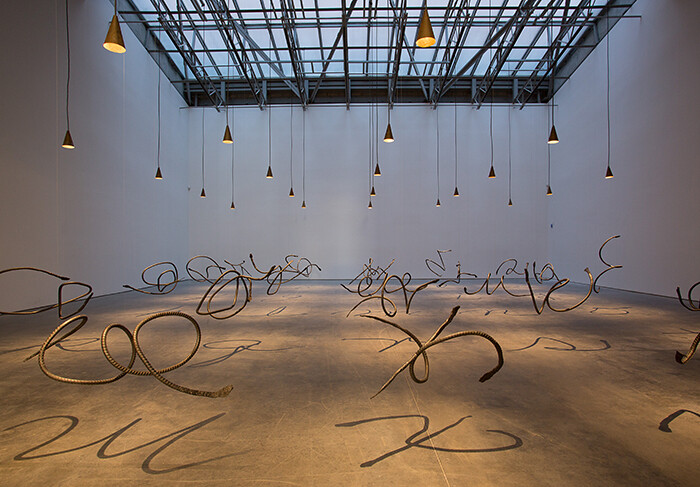If language is a tool then two things follow: there was a time before the tool was useful, hanging in a pre-anthropological state of potential, and there may come a time when it once again becomes useless. Similarly, if the sign is arbitrary, then there was a time before it settled on its current referent and the moment may come when it detaches itself again from it, like obsolete code. This sort of speculative linguistic archaeology—taking its cue from Wittgenstein and Saussure—finds an imaginative, sculptural dramatization in Damián Ortega’s new work at Gladstone Gallery. As the consummate bricoleur, Ortega redirects his affinity for assembly and disassembly of objects onto systems of language, uncovering the complex relations between materiality, symbolism, inscription, and the perception of meaning resulting from their interaction.
The centerpiece of the show is Harvest (2013), a large installation of some twenty steel sculptures hovering mid-air and evenly distributed throughout the main space of the gallery. Thin shapes tracing lines in space, they read like corrugated tire irons crossed with cobras in suspended animation. Their appearance straddles the line between objects of human techné and organic shapes resulting from nonhuman forces, like the speculative first bone-tool in Stanley Kubrick’s 1968 classic science fiction film 2001. Cutting through an otherwise dimly lit room, the overhead lights illuminate each sculpture and cast high-contrast shadows directly onto the concrete floor, such that these three-dimensional shapes can suddenly be read as two-dimensional inscriptions on the floor. A short history of shadows might point in any number of directions: the allegory of Plato’s cave, or the Corinthian maid who invented painting by tracing a loved one’s shadow profile. More fundamentally still, it was the first index, sign, or metaphor that touched off whole new systems of representation against the earliest fire-lit, stone walls. As carriers of meaning, these objects are imbued with historical and epistemological obscurity, and the solemn, austere, and paleontological feel of the installation lends itself to this sort of speculative anthropological thinking.
Ancillary works are also displayed outside the main space in the gallery. These include Calligraphy (2013), two C-prints representing an expanded taxonomic chart derived from the symbols in Harvest; Three Letters (2013), a metal hammer, chisel, and saw laying next to each other; and Content (Eyes, Hammer, The Beast) (2013), a collection of objects such as a bionic-like pair of eyes crossed with headlights, a hammer with a rope entangled like intestines, and a small birdcage-type object completely filled with material. How do these relate to Harvest? Did they bring about its suspended symbols (or at least alter their readymade organic profiles leading to different uses and meanings), or was it the other way around? Did the need to understand these forms or bend them to our will give rise to the required tools? In other words, was the idea derived from the tools, or do the tools lead to the idea?
These questions are especially difficult to answer when thinking of language, since its forms and ideas have been married for so long as to seem inseparable. This is where Harvest is at its most interesting—namely, when we understand its three-dimensional shapes to be a material form or speculative realism prior to usage, inscription, and meaning—meaning prior even to any symbolic designation of “material” or “form” in a state from which even our most temporally adventurous imaginations can only intrude. In this respect, close attention should be paid to Ortega’s use of naming: a harvest of hybrid shapes that write on the ground, common tools called letters, and biotechnical objects that supply content. From this nexus, three categories necessary for language and meaning—symbols, tools, and the perceptual faculties that allow us to use and contain them—all become intertwined in a mysterious loop.
The second floor of the gallery houses Ortega’s series “Tool Bones” (2013). Made of bronze that uncannily mimics wood, they make the room feel like a natural history of failed tools. Take Tool Bones 7 (2013), for example, an obdurate mass with a half-formed shovel protruding from one of its sides. Here again we might have form before “form”—its use, and its possession in hand or mind. The fact that these shapes harken back, in part, to a readymade object from within the (human or nonhuman) animal body, shows how Ortega is once again hybridizing techné with organicity. Given that today it is ecologically anachronistic to think that the world is made in humanity’s own image, this piece suggests the inverse: what we formerly took as our own image everywhere is simply the result of measuring, understanding, and manipulating the world according to our own bodily and mental needs and projections. This was only natural, since being is always what is closest to us (so close, in fact, that it can be missed altogether). In the end, Ortega’s exhibition addresses this over-familiarity and seems to de-familiarize our perception of language and its symbols, laying bare its component parts, and leaves behind its brute objects that toggle between use and uselessness, which may amount to the very edges of meaning and meaninglessness.









